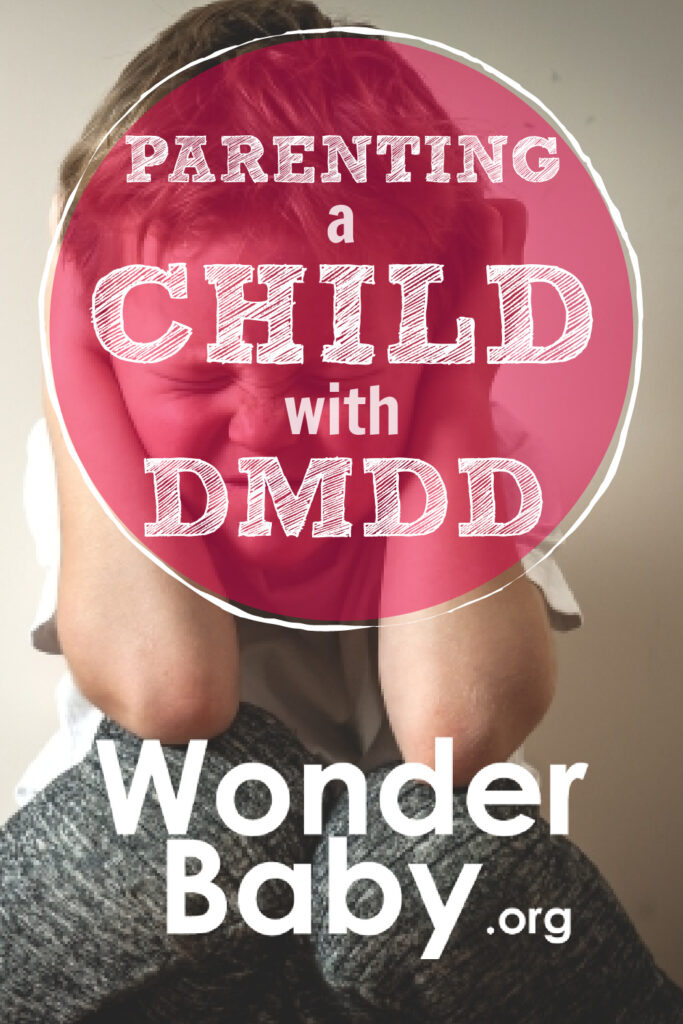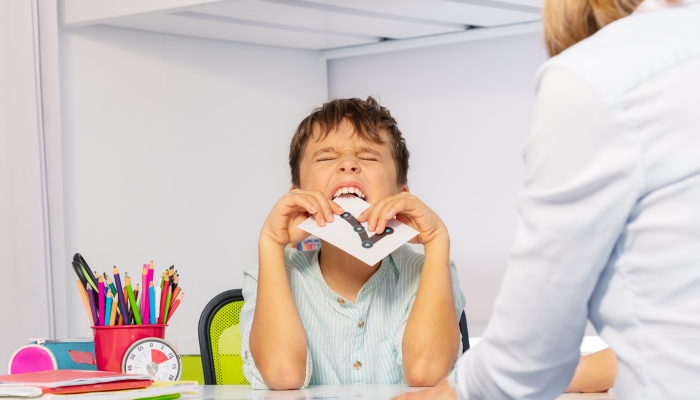Parenting a Child With DMDD

- Children with DMDD have chronic irritability and frequent angry outbursts.
- DMDD requires medical treatment.
- Symptoms of DMDD improve as your child learns skills for emotional regulation.
Temper tantrums are a hallmark of childhood as children learn emotional regulation. Unfortunately, children don’t have instruction manuals, and many parents find emotional development challenging. How do you know if your child is strong-willed or if there’s cause to worry about their behavior?
Temper tantrums occur most frequently between ages one and four. During this age range, tantrums average up to one a day, lasting between two and 15 minutes. They may be physical or verbal, or both. As your child becomes school-aged, tantrums should decrease.
If your child experiences extreme, persistent irritability, extreme or prolonged outbursts, or if tantrums regularly continue once school-aged, you should talk to your child’s pediatrician. Your child may be experiencing disruptive mood dysregulation disorder (DMDD). Medical intervention with a mental health professional and parental support are required in the management of DMDD for improved mental health.
What Is DMDD?
Disruptive mood dysregulation disorder (DMDD) is a relatively new diagnosis and was first identified in 2013 by the Diagnostic and Statistical Manual of Mental Disorders (DSM-5). The National Institute of Mental Health (NIMH) identifies DMDD as a childhood mood disorder with “extreme irritability, anger, and frequent, intense temper outbursts.”
Concerns raised about the dramatic increase of children diagnosed with bipolar disorder led to the creation of a new DMDD diagnosis. Many children before 2013 received the diagnosis of bipolar disorder when they did not meet all of the necessary criteria listed in the DSM-5. DMDD more accurately diagnoses children with a mood disorder that aligns with their symptoms.
The symptoms of DMDD exceed the typical tantrums and mood changes of childhood. Children with DMDD have frequent, intense, and ongoing episodes of irritability and anger. These repeated outbursts significantly affect children’s ability to function at home, at school, and with peers and require medical intervention.
The science is not clear yet on the causes of DMDD, but many factors may contribute. These factors may include familial history, brain chemistry, temperament, and co-occurring mental conditions
.
DMDD Symptoms and Signs
Children with disruptive mood dysregulation disorder can often have symptoms associated with multiple other psychiatric disorders, such as oppositional defiant disorder, bipolar disorder, and depression. It can be confusing, but understanding the signs of DMDD will help you learn and advocate for your child.
According to the American Academy of Child & Adolescent Psychiatry (AACAP), the criteria for a diagnosis of DMDD include:
- Severe, recurrent temper outbursts at least three times a week
- Persistent irritable or angry mood between outbursts for most of the day nearly every day
- Reaction is out of proportion to the situation and is inconsistent with developmental stage
- Child must be between the ages of 6 – 18 years old
- Onset of symptoms by ten years of age
- Symptoms are present for at least 12 months
- Behaviors occur in 2 or more settings (e.g., at home, at school, with friends)
One thing to keep in mind is that temper outbursts can be either verbal or behavioral or both.
During development, children learn to cope with disappointment and frustration. All children can become irritable in response to frustration, but children who experience DMDD find tolerating disappointment and frustration extremely difficult. This frustration leads to extreme irritability and outbursts that are out of proportion to the situation.

Treatment Options for DMDD
Disruptive mood dysregulation disorder has a profound impact on the child’s life, and it is essential to seek medical treatment as soon as possible.
Currently, there is still so much that is unknown about DMDD. Not enough time has elapsed for research studies and there is no specific guideline for the treatment of the condition. Based on therapies that have worked well for similar conditions, treatment options include psychotherapy, medication, or a combination of both.
Psychotherapy
A standard treatment option used for DMDD is cognitive behavioral therapy (CBT). During treatment, your child identifies thoughts and feelings that contribute to their anger and irritability. With their therapist, they work to identify coping skills. They practice responding to situations that trigger their outbursts. Through repeated exposure to events that elicit irritability and anger, clinicians help your child increase their tolerance to frustration.
Parent Training
Parents and caregivers are instrumental in supporting children with DMDD. Adding a parent training program can complement your child’s treatment. Parent training teaches you awareness of your child’s triggers, and you will learn effective responses to manage emotional outbursts. You will develop an awareness of your child’s emotions that leads to anticipating outbursts. You can then proactively use strategies to avert outbursts. Training also focuses on helping you be consistent with your child and developing a reward system for positive behavior.
Medications
The U.S. Food and Drug Administration (FDA) has not approved specific medications for treating children or adolescents with disruptive mood dysregulation disorder. Medications used in the management of DMDD have been effective in managing other disorders with similarly occurring symptoms. Medicines prescribed to help improve your child’s symptoms include:
- Stimulant medications – increase alertness, attention, and energy and are commonly used to treat ADHD. There is evidence to suggest that children with DMDD respond well to stimulants and have little risk for adverse emotional effects.
- Antidepressants – Used to treat irritability associated with DMDD; however, further research is needed to verify effectiveness. Although antidepressants are deemed safe and effective for use in children, there is an increased risk for suicidal thoughts and behaviors.
- Atypical antipsychotics – Used to treat children with irritability and severe outbursts that involve physical aggression. The FDA has approved some atypical antipsychotic medications to treat irritability associated with autism spectrum disorders. These medications are associated with significant side effects including suicidal thoughts, weight gain, and metabolic abnormalities. Due to the side effects of these medications, utilization occurs when other management strategies have failed to improve symptoms.
Talk with your child’s health care provider to understand the recommendations of medications for your child and the side effects of the drug.
Challenges of Raising a Child With DMDD
Being the parent of a child with disruptive mood dysregulation disorder is stressful. Your child has chronic, severe irritability and severe temper outbursts, and these intense emotions affect the entire family. The outbursts are difficult to watch and you may feel helpless in the moment. However, there are things you can do before, during, and after an outburst.
Safety is the top priority. Identify a safe space in your environment where your child can go during an outburst. If your child reacts with physical aggression, prevent self-injury by removing any sharp or breakable objects, removing any heavy objects that can be thrown, and ensuring furniture is safely secured. Make sure you identify this space with your child outside of anger outbursts so they are aware of the plan.
Once your child calms down from an anger outburst, it may be challenging to know how to proceed. You may feel conflicted about whether to comfort your child or discipline them. Take some time to collect your thoughts. When your head has cleared, and you are both calm, speak openly to your child about their behavior. Let your child know you love them but their behavior was unacceptable. Talk with them to identify what triggered the anger and identify strategies to improve their behavior in the future.

Parenting Tips for Children With DMDD
- Identify your child’s emotions – Recognize and track emotional changes in a journal, noting the environment and events before the change. Tracking will allow you and your child to learn more about their moods, identify triggers, and identify patterns that may be present.
- Create consistent routines – Routines allow children to understand patterns and support self-regulation skills. Children can anticipate activities leading to less decision-making and decreasing feelings of overwhelm.
- Stay calm – Emotional energy is transferable so you may feel angry or irritable during your child’s outburst. If you think your mood is shifting with your child, take a few deep breaths to refocus your attention and calm your nervous system. Additionally, staying calm helps to model the best behavior for your child.
- Identify clear rules and consequences – Creating clear rules and appropriate consequences for breaking them should be discussed with your child when they are calm. Rules allow your child to understand your expectations and help you be consistent with discipline.
- Positive reinforcement – Was your child able to comb their hair, brush their teeth, or try food offered at a meal? Identify areas where your child exhibits appropriate behavior and reward with attention and praise. Offering rewards or extra privileges for positive behaviors will encourage your child to continue making good choices.
- Self-care – Taking care of yourself isn’t selfish. It allows you to have the energy and emotional reserve to be there for your child. At a minimum, try getting adequate sleep, eating a balanced diet, and exercising. Additionally, identify an activity you enjoy and set aside time to do it.
- Seek help – Parenting a child with DMDD requires patience and specific skills to manage misbehaviors. Professional support is needed. A good starting place is with your child’s pediatrician. Access help for yourself through a parenting coach or a therapist, and identify an alternate caregiver that can step in and give you a break when needed.
FAQs
Can a child grow out of DMDD?
As your child develops emotional awareness and regulation skills, temper outbursts should decrease. However, they will continue to experience intense emotions and may start to internalize their feelings. For this reason, adolescents and adults with DMDD are at higher risk for other mental health disorders such as anxiety and depression.
Is there medication for treating anger outbursts in children?
Medications are used to treat anger outbursts in children, however, treatment approaches vary. Consult with your medical provider to develop a plan that includes therapy, medications, or both.
During what ages is disruptive mood dysregulation disorder most common?
Symptoms of DMDD typically begin before the age of 10. A child must be between the ages of six and 18 years to diagnose DMDD.
What discipline strategies can I use to help my child with DMDD?
Providing your child with clear rules and boundaries allows them to understand expectations. For example, “when you throw your food, mealtime will be over.”
Offer ample opportunities to learn emotional regulation strategies. Check-in with your child after an outburst to review the cause and identify any improvements for future situations. Use time outs cautiously as they may increase irritability and leave your child feeling isolated.
Finally, be sure to read our guide on how to discipline a child with DMDD. You may also find discipline strategies used for children with ADHD helpful.
How do I know if my child has DMDD or if they have bipolar disorder?
Children with both bipolar disorder (BP) and DMDD suffer from irritability and emotional dysregulation. The irritability associated with BP is episodic, meaning it comes and goes. Children with DMDD are chronically irritable.
In addition, children with BP also experience periods of mania and periods of depression. These cycles are a critical difference between DMDD and bipolar disorder.
Consult with your child’s health care team and share your concerns to determine if your child has a mood disorder.
How do I know if my child has DMDD or Oppositional Defiance Disorder?
DMDD and oppositional defiance disorder (ODD) are often confused because of their similarities. Children who live with these disorders both have irritability and extreme behavioral outbursts that impact their lives. Some symptoms that may be present in ODD that are different from DMDD include:
- Refusal to comply with requests from adults
- Blaming others for their misbehaviors or mistakes
- Doing things to annoy or upset others
- Being vindictive or seeking revenge

Related Posts

Behavior
Understanding Intermittent Explosive Disorder in Children
Are you worried about your child’s unexpected aggression and explosive behaviors? Learn how to support a child with intermittent explosive disorder.

Behavior
5 Emotional Regulation Activities for Kids
Want to teach your child how to regulate emotions? Here are emotional regulation activities for kids that can help!

Behavior, Special Needs
5 Tips for Dining Out with Children Who Have Sensory Sensitivities
Worried about dining out with sensory sensitivities? Try these tips for less stress and more fun the next time you take your family out to eat.